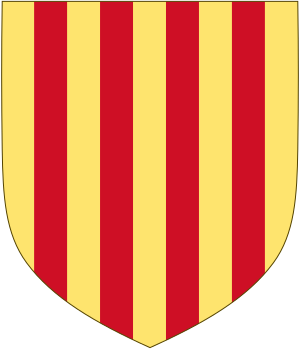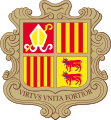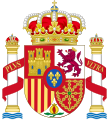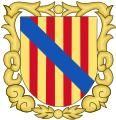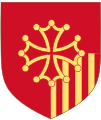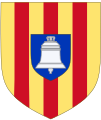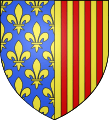Coat of arms of the Crown of Aragon facts for kids
The Bars of Aragon are a famous symbol. You might also hear them called the Royal Arms of Aragon or the Four Red Bars. This symbol shows four red stripes (called "pallets" in heraldry) on a gold background. It was the special emblem of the Kings of Aragon for a very long time.
This symbol is super old! It dates back to a seal from 1150, used by Raymond Berengar IV, who was the Count of Barcelona and Prince of Aragon.
Today, you can see this symbol in many places that were once part of the Crown of Aragon. For example, it's on the coat of arms of Spain. It's also a main part of the symbols for Spanish regions like Catalonia, the Valencian Community, and the Balearic Islands. You can even find it in parts of France and Italy, like Provence-Alpes-Côte d'Azur and Occitania. Many towns and cities that were once directly linked to the Crown of Aragon also use these bars in their own coats of arms.
Contents
What the Symbol Looks Like
In the language of heraldry (the study of coats of arms), the Bars of Aragon are described as: Or, four pallets of gules. This simply means:
- Or (pronounced "ore") means gold. So, the background is gold.
- Pallets are narrow vertical stripes.
- Gules (pronounced "gyoolz") means red. So, the stripes are red.
So, it's a gold shield with four red vertical stripes. People often just call them the "red bars" or the "four bars."
This symbol has been recognized for centuries. Old books about coats of arms from the Middle Ages, like the "Armorial du Hérault Vermandois" (from 1285–1300), describe it as the arms of the King of Aragon.
A Brief History
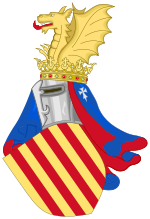
The Bars of Aragon were originally the special symbol of the Kings of Aragon and the Counts of Barcelona. A big change happened in 1137. The Kingdom of Aragon and the County of Barcelona joined together through a dynastic union. This happened when Raymond Berengar IV of Barcelona married Petronila of Aragon.
Their son, Alfonso II of Aragon, became king in 1162. He was the first person to hold both titles: King of Aragon and Count of Barcelona. Over time, all the lands and territories ruled by this family became known as the Crown of Aragon. The symbol of the Bars of Aragon then represented this powerful Crown.
Today, this historic symbol is still an important part of the coat of arms of the Kingdom of Spain.
Where Did It Come From?
The exact beginning of the "four bars" symbol is a bit of a mystery! For a long time, people told legends about its origin, but these stories aren't true. The first clear evidence of the symbol comes from the time of Alfonso II of Aragon, who was both King of Aragon and Count of Barcelona.
Some historians believe the symbol is linked to the Counts of Barcelona because very old designs that look like red bars on a yellow background have been found on tombs from the 11th century. Others argue that because Ramon Berenguer IV, Count of Barcelona was a very important ruler in Aragon, any symbol connected to him could also be seen as representing the early Crown of Aragon. What we do know is that it's a very old and important symbol with deep roots in the history of both Aragon and Barcelona.
Variations of the Arms
You can see the Bars of Aragon in the coats of arms of many different places today.
Arms of Countries
Arms of Modern Regions
The Bars appear in the arms of several regions in Spain, France, and Italy. These areas were once part of the Crown of Aragon.
-
The coat of arms of Aragon
-
The coat of arms of the Balearic Islands
-
The coat of arms of Catalonia
-
The coat of arms of the Valencian Community
-
The coat of arms of the Province of Alicante
-
The coat of arms of the Province of Barcelona
-
The coat of arms of the Province of Tarragona
-
The coat of arms of the department of Ariège
-
The coat of arms of the department of Lozère
-
The coat of arms of the department of Pyrénées-Orientales
-
The coat of arms of
Provence-Alpes-Côte d'Azur
-
The coat of arms of the Province of Catanzaro
-
The coat of arms of the Province of Lecce
-
The coat of arms of the Province of Reggio Calabria
Arms of Cities
Many cities that were part of the Crown of Aragon also feature the Bars in their coats of arms.
-
The coat of arms of Aix-en-Provence
-
The coat of arms of Albarracín
-
The coat of arms of Alcañiz
-
The coat of arms of Alghero
-
The coat of arms of Barcelona
-
The coat of arms of Cariñena
-
The coat of arms of Caspe
-
The coat of arms of Cervera
-
The coat of arms of Cuarte de Huerva
-
The coat of arms of Foix
-
The coat of arms of Fraga
-
The coat of arms of Girona
-
The coat of arms of Lleida
-
The coat of arms of Palma de Mallorca
-
The coat of arms of Perpignan
-
The coat of arms of Sabiñánigo
-
The coat of arms of Salamanca
-
The coat of arms of Tamarite de Litera
-
The coat of arms of Tarragona
-
The coat of arms of Teruel
-
The coat of arms of Utebo
-
The coat of arms of Valencia
See also
 In Spanish: Señal Real de Aragón para niños
In Spanish: Señal Real de Aragón para niños
- Bat (heraldry)
- Coat of arms of Spain
- Heraldry of Castile
- Heraldry of León
- Senyera
- Spanish heraldry


